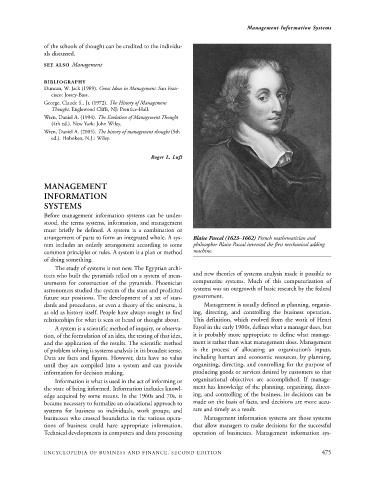Page 498 - Encyclopedia of Business and Finance
P. 498
eobf_M 7/5/06 3:15 PM Page 475
Management Information Systems
of the schools of thought can be credited to the individu-
als discussed.
SEE ALSO Management
BIBLIOGRAPHY
Duncan, W. Jack (1989). Great Ideas in Management. San Fran-
cisco: Jossey-Bass.
George, Claude S., Jr. (1972). The History of Management
Thought. Englewood Cliffs, NJ: Prentice-Hall.
Wren, Daniel A. (1994). The Evolution of Management Thought
(4th ed.). New York: John Wiley.
Wren, Daniel A. (2005). The history of management thought (5th
ed.). Hoboken, N.J.: Wiley.
Roger L. Luft
MANAGEMENT
INFORMATION
SYSTEMS
Before management information systems can be under-
stood, the terms systems, information, and management
must briefly be defined. A system is a combination or
arrangement of parts to form an integrated whole. A sys- Blaise Pascal (1623–1662) French mathematician and
tem includes an orderly arrangement according to some philosopher Blaise Pascal invented the first mechanical adding
common principles or rules. A system is a plan or method machine.
of doing something.
The study of systems is not new. The Egyptian archi-
tects who built the pyramids relied on a system of meas- and new theories of systems analysis made it possible to
urements for construction of the pyramids. Phoenician computerize systems. Much of this computerization of
astronomers studied the system of the stars and predicted systems was an outgrowth of basic research by the federal
future star positions. The development of a set of stan- government.
dards and procedures, or even a theory of the universe, is Management is usually defined as planning, organiz-
as old as history itself. People have always sought to find ing, directing, and controlling the business operation.
relationships for what is seen or heard or thought about. This definition, which evolved from the work of Henri
A system is a scientific method of inquiry, or observa- Fayol in the early 1900s, defines what a manager does, but
tion, of the formulation of an idea, the testing of that idea, it is probably more appropriate to define what manage-
and the application of the results. The scientific method ment is rather than what management does. Management
of problem solving is systems analysis in its broadest sense. is the process of allocating an organization’s inputs,
Data are facts and figures. However, data have no value including human and economic resources, by planning,
until they are compiled into a system and can provide organizing, directing, and controlling for the purpose of
information for decision making. producing goods or services desired by customers so that
Information is what is used in the act of informing or organizational objectives are accomplished. If manage-
the state of being informed. Information includes knowl- ment has knowledge of the planning, organizing, direct-
edge acquired by some means. In the 1960s and 70s, it ing, and controlling of the business, its decisions can be
became necessary to formalize an educational approach to made on the basis of facts, and decisions are more accu-
systems for business so individuals, work groups, and rate and timely as a result.
businesses who crossed boundaries in the various opera- Management information systems are those systems
tions of business could have appropriate information. that allow managers to make decisions for the successful
Technical developments in computers and data processing operation of businesses. Management information sys-
ENCYCLOPEDIA OF BUSINESS AND FINANCE, SECOND EDITION 475

